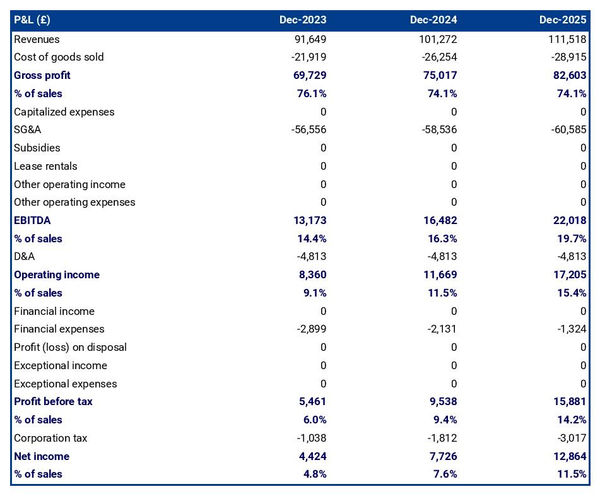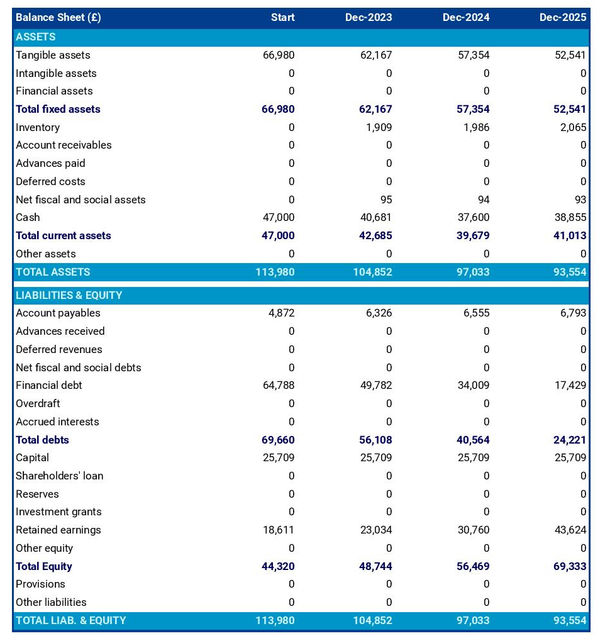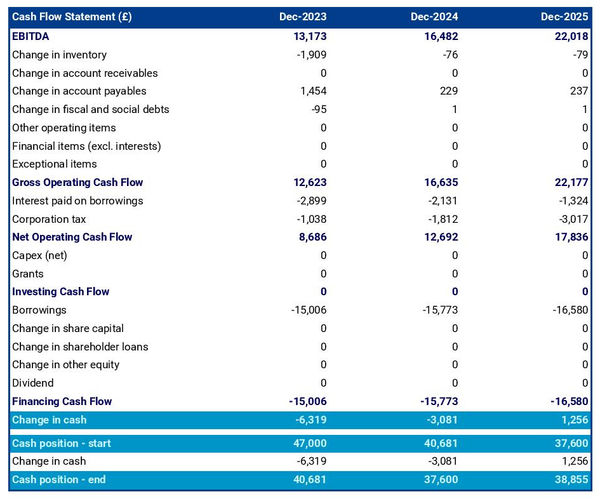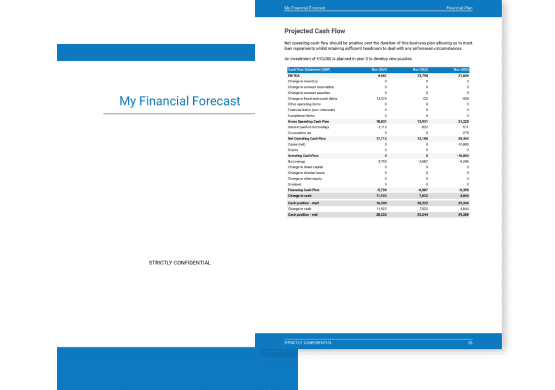How to create a financial forecast for a restaurant?

Developing and maintaining an up-to-date financial forecast for your restaurant is key in order to maintain visibility on your business’s future cash flows.
If you feel overwhelmed at the thought of putting together a restaurant financial forecast then don’t worry as this guide is here to help you.
We'll cover everything from: the main objectives of a financial forecast, the data you need to gather before starting, to the tables that compose it, and the tools that will help you create and maintain your forecast efficiently.
Let's get started!
Why create and maintain a financial forecast for a restaurant?
The financial projections for your restaurant act as a financial blueprint to guide its growth with confidence and ensure its long-term financial viability.
To create them, you will need to look at your business in detail - from sales to operating costs and investments - to assess how much profit it can generate in the years to come and what will be the associated cash flows.
During challenging market conditions, maintaining an up-to-date financial forecast enables early detection of potential financial shortfalls, allowing for timely adjustments or securing financing before facing a cash crisis.
Your restaurant's financial forecast will also prove invaluable when seeking financing. Banks and investors will undoubtedly request a thorough examination of your financial figures, making precision and presentation essential.
Need a solid financial forecast?
The Business Plan Shop does the maths for you. Simply enter your revenues, costs and investments. Click save and our online tool builds a three-way forecast for you instantly.

What information is used as input to build a restaurant financial forecast?
A restaurant's financial forecast is only as good as the inputs used to build it.
If you are creating (or updating) the forecast of an existing restaurant, then you mostly need your accounting information, key historical operating non-financial data, and your team’s input on what to expect for the coming years.
If you are building financial projections for a restaurant startup, you will need to have done your research and have a clear picture of your competitive environment and go-to-market strategy so that you can forecast sales accurately.
For a new venture, you will also need a precise list of the resources needed to keep the restaurant running on a day-to-day basis and a list of the equipment and expenditures required to start the business (more on that later).
Let's now take a closer look at the elements that make up your restaurant's financial forecast.
The sales forecast for a restaurant
The sales forecast, also called topline projection, is normally where you will start when building your restaurant financial forecast.
Creating a coherent sales projection boils down to estimating two key drivers:
- The average price
- The number of monthly transactions
To do this, you will need to rely on historical data (for an existing business), market research data (for both new and existing restaurants), and consider the elements below:
- Seasonal Fluctuations: As a restaurant owner, you are likely to experience seasonal fluctuations in both your average price and number of monthly transactions. For example, during the summer months, you may see an increase in the number of customers and therefore, a higher average price due to increased demand. However, during the winter months, you may see a decrease in both due to colder weather and fewer tourists.
- Menu Changes: Regularly changing your menu can have a significant impact on your average price and number of monthly transactions. For instance, introducing new, more expensive dishes can increase your average price, but may also result in fewer transactions if customers are hesitant to try something new. On the other hand, offering promotions or discounts on certain dishes can attract more customers and increase your number of transactions, but may lower your average price.
- Economic Factors: Changes in the economy can greatly affect your restaurant's average price and number of monthly transactions. In times of economic downturn, customers may be more price-sensitive and opt for cheaper options, resulting in a lower average price and fewer transactions. However, during a strong economy, customers may be more willing to spend money and try new, more expensive dishes, resulting in a higher average price and more transactions.
- Location: The location of your restaurant can also play a role in your average price and number of monthly transactions. For example, if your restaurant is located in a busy, high-traffic area, you may attract more customers and have a higher average price due to convenience and visibility. However, if your restaurant is located in a less populated area, you may have fewer monthly transactions and a lower average price.
- Competition: The presence of competitors in your area can affect your restaurant's average price and number of monthly transactions. If you have a lot of competition, you may need to lower your prices to stay competitive, resulting in a lower average price. However, if you have a unique concept or offer high-quality dishes, you may be able to charge a higher average price and attract more customers despite competition.
After the sales forecast comes the operating expenses budget, which we will now look into in more detail.
Need inspiration for your business plan?
The Business Plan Shop has dozens of business plan templates that you can use to get a clear idea of what a complete business plan looks like.

The operating expenses for a restaurant
The next step is to estimate the expenses needed to run your restaurant on a day-to-day basis.
These will vary based on the level of sales expected, and the location and size of your business.
But your restaurant's operating expenses should include the following items at a minimum:
- Staff Costs: This includes salaries, wages, and benefits for all employees, including kitchen staff, servers, bartenders, and management.
- Food and Beverage Costs: This covers the cost of all ingredients and supplies needed to prepare and serve meals and drinks.
- Rent and Utilities: You will need to pay rent for the restaurant space, as well as cover the cost of utilities such as electricity, water, and gas.
- Accountancy Fees: This covers the cost of hiring an accountant to help you with bookkeeping, tax filings, and other financial tasks.
- Insurance Costs: You will need to have insurance to protect your restaurant from potential risks, such as liability claims or property damage.
- Marketing and Advertising: This includes the cost of promoting your restaurant through advertising, social media, and other marketing efforts.
- Software Licences: You will need to pay for software licences for your point of sale system, accounting software, and other tools you use to run your restaurant.
- Banking Fees: This covers the cost of maintaining a business bank account, processing credit card payments, and other banking services.
- Cleaning and Maintenance: You will need to regularly clean and maintain your restaurant to ensure a hygienic and inviting environment for your customers.
- Kitchen Supplies: This includes the cost of purchasing and restocking cooking equipment, utensils, and other necessary supplies for the kitchen.
- Linens and Tableware: You will need to regularly replace linens and tableware, such as napkins, tablecloths, and plates, to maintain a clean and professional dining experience.
- Training and Development: This covers the cost of training new employees and providing ongoing development opportunities for your staff.
- Waste Disposal: You will need to pay for waste removal and recycling services to keep your restaurant clean and environmentally-friendly.
- Legal Fees: This includes the cost of hiring a lawyer to help with legal matters related to your restaurant, such as contracts, permits, and compliance.
- Entertainment and Events: This covers the cost of hosting special events and providing entertainment for customers, such as live music or themed nights.
This list is, of course, not exhaustive, and you'll have to adapt it according to your precise business model and size. A small restaurant might not have the same level of expenditure as a larger one, for example.
What investments are needed to start or grow a restaurant?
Creating and expanding a restaurant also requires investments which you need to factor into your financial forecast.
Capital expenditures and initial working capital items for a restaurant could include elements such as:
- Kitchen equipment: This includes items such as ovens, refrigerators, fryers, and other cooking and food preparation equipment. These are essential for the daily operations of a restaurant and can be a significant capital expenditure.
- Furniture and fixtures: This includes tables, chairs, booths, and other furnishings for the dining area. These items not only provide a comfortable dining experience for your customers but also contribute to the overall aesthetic of your restaurant.
- POS system: A point-of-sale system is necessary for tracking sales, inventory, and other important data. This can include hardware such as cash registers, computers, and printers, as well as software for managing orders and payments.
- Renovations and improvements: Depending on the location and condition of your restaurant, you may need to make renovations or improvements to the space. This could include updating the interior design, adding outdoor seating, or making structural changes.
- Technology and IT equipment: In today's digital age, technology plays a crucial role in the restaurant industry. This can include computers, tablets, and other devices for managing reservations, online orders, and marketing efforts.
Again, this list is not exhaustive and will need to be adjusted according to the circumstances of your restaurant.
Need a convincing business plan?
The Business Plan Shop makes it easy to create a financial forecast to assess the potential profitability of your projects, and write a business plan that’ll wow investors.

The financing plan of your restaurant
The next step in the creation of your financial forecast for your restaurant is to think about how you might finance your business.
You will have to assess how much capital will come from shareholders (equity) and how much can be secured through banks.
Bank loans will have to be modelled so that you can separate the interest expenses from the repayments of principal, and include all this data in your forecast.
Issuing share capital and obtaining a bank loan are two of the most common ways that entrepreneurs finance their businesses.
What tables compose the financial plan for a restaurant?
Now let's have a look at the main output tables of your restaurant's financial forecast.
The forecasted profit & loss statement
The profit & loss forecast gives you a clear picture of your business’ expected growth over the first three to five years, and whether it’s likely to be profitable or not.

A healthy restaurant's P&L statement should show:
- Sales growing at (minimum) or above (better) inflation
- Stable (minimum) or expanding (better) profit margins
- A healthy level of net profitability
This will of course depend on the stage of your business: numbers for an established restaurant will look different than for a startup.
The projected balance sheet
The projected balance sheet gives an overview of your restaurant's financial structure at the end of the financial year.
It is composed of three categories of items: assets, liabilities and equity:
- Assets: are what the business possesses and uses to produce cash flows. It includes resources such as cash, buildings, equipment, and accounts receivable (money owed by clients).
- Liabilities: are the debts of your restaurant. They include accounts payable (money owed to suppliers), taxes due and bank loans.
- Equity: is the combination of what has been invested by the business owners and the cumulative profits to date (which are called retained earnings). Equity is a proxy for the value of the owner's stake in the business.

The cash flow projection
The cash flow forecast of your restaurant will show how much cash the business is expected to generate or consume over the next three to five years.

There are multiple ways of presenting a cash flow forecast but from experience, it is better to organise it by nature in order to clearly show these elements:
- Operating cash flow: how much cash is generated by the restaurant's operations
- Investing cash flow: what is the business investing to expand or maintain its equipment
- Financing cash flow: is the business raising additional funds or repaying financiers (debt repayment, dividends)
Your cash flow forecast is the most important element of your overall financial projection and that’s where you should focus your attention to ensure that your restaurant is adequately funded.
Note: if you are preparing a financial forecast in order to try to secure funding, you will need to include both a yearly and monthly cash flow forecast in your restaurant's financial plan.
Need a solid financial forecast?
The Business Plan Shop does the maths for you. Simply enter your revenues, costs and investments. Click save and our online tool builds a three-way forecast for you instantly.

Which tool should you use to create your restaurant's financial projections?
Building a restaurant financial forecast is not difficult provided that you use the right tool for the job. Let’s see what options are available below.
Using online financial forecasting software to build your restaurant's projections
The modern and easiest way is to use professional online financial forecasting software such as the one we offer at The Business Plan Shop.
There are several advantages to using specialised software:
- You can easily create your financial forecast by letting the software take care of the financial calculations for you without errors
- You have access to complete financial forecast templates
- You get a complete financial forecast ready to be sent to your bank or investors
- You can easily track your actual financial performance against your financial forecast, and recalibrate your forecast as the year goes by
- You can create scenarios to stress test your forecast's main assumptions
- You can easily update your forecast as time goes by to maintain visibility on future cash flows
- You have a friendly support team on standby to assist you when you are stuck
- It’s cost-efficient and much cheaper than using an accountant or consultant (see below)
If you are interested in this type of solution, you can try our forecasting software for free by signing up here.
Calling in a financial consultant or chartered accountant
Enlisting the help of a consultant or accountant is also a good way to obtain a professional restaurant financial forecast.
The downside of this solution is its cost. From experience, obtaining a simple financial forecast over three years (including a balance sheet, income statement, and cash flow statement) is likely to cost a minimum of £700 or $1,000.
The indicative cost above, is for a small business, and a forecast is done as a one-shot exercise. Using a consultant or accountant to track your actuals vs. forecast and to keep your financial projections up to date on a monthly or quarterly basis will cost a lot more.
If you opt for this solution, make sure your accountant has in-depth knowledge of your industry, so that they may challenge your figures and offer insights (as opposed to just taking your assumptions at face value to create the forecast).
Why not use a spreadsheet such as Excel or Google Sheets to build your restaurant's financial forecast?
Creating an accurate and error-free restaurant financial forecast on Excel (or any spreadsheet) is very technical and requires both a strong grasp of accounting principles and solid skills in financial modelling.
Most entrepreneurs lack the expertise required to create an accurate financial forecast using spreadsheet software like Excel or Google Sheets. As a result, it is unlikely anyone will trust your numbers.
The second reason is that it is inefficient. Building forecasts on spreadsheets was the only option in the 1990s and early 2000s, nowadays technology has advanced and software can do it much faster and much more accurately.
This is why professional forecasters all use software. With the rise of AI, software is also becoming smarter at helping us detect mistakes in our forecasts and helping us analyse the numbers to make better decisions.
Finally, like everything with spreadsheets, tracking actuals vs. forecasts and updating your forecast as the year progresses is manual, tedious, error-prone, and time-consuming. Whereas financial forecasting software like The Business Plan Shop is built for this.
Need a convincing business plan?
The Business Plan Shop makes it easy to create a financial forecast to assess the potential profitability of your projects, and write a business plan that’ll wow investors.

Use our financial projection templates for inspiration
The Business Plan Shop has dozens of financial forecasting templates available.
Our examples contain both the financial forecast, and a written business plan which presents, in detail, the company, the team, the strategy, and the medium-term objectives.
Whether you are just starting out or already have your own restaurant, looking at our template is always a good way to get ideas on how to model financial items and what to write when creating a business plan to secure funding.

Takeaways
- A financial forecast shows expected growth, profitability, and cash generation metrics for your restaurant.
- Tracking actuals vs. forecast and having an up-to-date financial forecast is key to maintaining visibility on your future cash flows.
- Using financial forecasting software is the modern way of creating and maintaining financial projections.
We hope that this guide helped you gain a clearer perspective on the steps needed to create the financial forecast for a restaurant. Don't hesitate to contact us if you have any questions!
Need inspiration for your business plan?
The Business Plan Shop has dozens of business plan templates that you can use to get a clear idea of what a complete business plan looks like.

Also on The Business Plan Shop
Know someone who runs a restaurant? Share our business guide with them!











